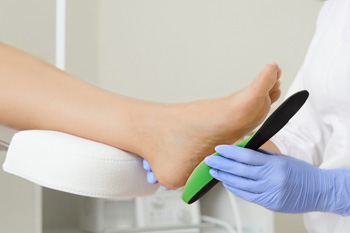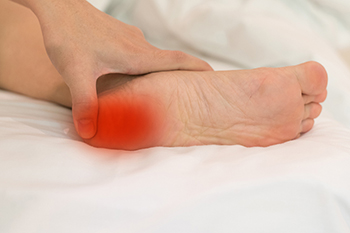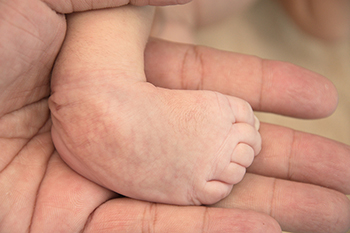Items filtered by date: March 2022
When to Consider Orthotics
 Orthotics are shoe or heel inserts that can help with a variety of foot, leg, and back problems. They can help the foot and ankle work better, correct foot deformities, and reduce risk for further injuries. Generic orthotics can be purchased online or in stores or they can be prescribed by a podiatrist and custom-made specifically for your needs. Orthotics have been used to deal with foot pain associated with arthritis, lack of foot cushioning, high arches, bunions, diabetic neuropathy, high arches, and other foot conditions. If you are experiencing foot or heel pain that is not relieved by over-the-counter treatments, exercises or rest, a podiatrist can examine the condition of your feet, watch you walk and perform movements, and possibly recommend imaging, such as an X-ray, bone scan, or MRI to identify specific problem areas and create custom orthotics and/or other avenues of treatment.
Orthotics are shoe or heel inserts that can help with a variety of foot, leg, and back problems. They can help the foot and ankle work better, correct foot deformities, and reduce risk for further injuries. Generic orthotics can be purchased online or in stores or they can be prescribed by a podiatrist and custom-made specifically for your needs. Orthotics have been used to deal with foot pain associated with arthritis, lack of foot cushioning, high arches, bunions, diabetic neuropathy, high arches, and other foot conditions. If you are experiencing foot or heel pain that is not relieved by over-the-counter treatments, exercises or rest, a podiatrist can examine the condition of your feet, watch you walk and perform movements, and possibly recommend imaging, such as an X-ray, bone scan, or MRI to identify specific problem areas and create custom orthotics and/or other avenues of treatment.
If you are having discomfort in your feet and would like to try orthotics, contact Donald Manger, DPM from Associated Podiatric Physicians, PA. Our doctor can provide the care you need to keep you pain-free and on your feet.
What Are Orthotics?
Orthotics are inserts you can place into your shoes to help with a variety of foot problems such as flat feet or foot pain. Orthotics provide relief and comfort for minor foot and heel pain but can’t correct serious biomechanical problems in your feet.
Over-the-Counter Inserts
Orthotics come in a wide variety of over-the-counter inserts that are used to treat foot pain, heel pain, and minor problems. For example, arch supports can be inserted into your shoes to help correct overarched or flat feet, while gel insoles are often used because they provide comfort and relief from foot and heel pain by alleviating pressure.
Prescription Orthotics
If over-the-counter inserts don’t work for you or if you have a more severe foot concern, it is possible to have your podiatrist prescribe custom orthotics. These high-quality inserts are designed to treat problems such as abnormal motion, plantar fasciitis, and severe forms of heel pain. They can even be used to help patients suffering from diabetes by treating foot ulcers and painful calluses and are usually molded to your feet individually, which allows them to provide full support and comfort.
If you are experiencing minor to severe foot or heel pain, it’s recommended to speak with your podiatrist about the possibilities of using orthotics. A podiatrist can determine which type of orthotic is right for you and allow you to take the first steps towards being pain-free.
If you have any questions please contact our office located in Hamilton Township, NJ . We offer the newest diagnostic and treatment technologies for all your foot and ankle needs.
Heel Pain Can Be Treated!
Teen Athletes Are Prone to Sever’s Disease
When your child is between 9 and 14 years old, the growth plate of the cartilage in the heel may not match the growth of the heel bone itself. This imbalance may cause a condition known as Sever’s disease, common in youngsters who play sports or are otherwise physically active. Luckily, it’s not actually a disease and will eventually subside as the child matures. Symptoms include swelling, stiffness in the feet, limping or walking on tiptoe, and pain in the heel. The main thing to do is stop the activity that may be at the root of the condition, especially if it calls for continued running and jumping on hard surfaces. Usually, low impact activities like swimming are not a problem. Sever’s disease generally subsides when the heel plate finishes growing, around the age of 15. If your younger teenage children are involved in sports, it is a good idea to introduce them to a podiatrist who can do regular examinations and treat any foot care problems as they arise.
Sever's disease often occurs in children and teens. If your child is experiencing foot or ankle pain, see Donald Manger, DPM from Associated Podiatric Physicians, PA. Our doctor can treat your child’s foot and ankle needs.
Sever’s Disease
Sever’s disease is also known as calcaneal apophysitis, which is a medical condition that causes heel pain I none or both feet. The disease is known to affect children between the ages of 8 and 14.
Sever’s disease occurs when part of the child’s heel known as the growth plate (calcaneal epiphysis) is attached to the Achilles tendon. This area can suffer injury when the muscles and tendons of the growing foot do not keep pace with bone growth. Therefore, the constant pain which one experiences at the back of the heel will make the child unable to put any weight on the heel. The child is then forced to walk on their toes.
Symptoms
Acute pain – Pain associated with Sever’s disease is usually felt in the heel when the child engages in physical activity such as walking, jumping and or running.
Highly active – Children who are very active are among the most susceptible in experiencing Sever’s disease, because of the stress and tension placed on their feet.
If you have any questions, please feel free to contact our office located in Hamilton Township, NJ . We offer the newest diagnostic and treatment technologies for all your foot and ankle injuries.
Dealing With a Sprained Toe
A common cause of a toe sprain is direct impact – bumping into something hard or dropping something heavy on the toe – which can injure the ligaments in the joint. The first thing to do is employ the RICE method of treatment: rest, ice, compression, and elevation. Rest: Try to stay off the foot as much as possible. Ice: This action helps reduce both pain and swelling. Compression: Unless it is the big toe, it is tough to wrap the injured area, so you may need to tape the injured toe to one next to it, being careful not to further injure the sore toe. Elevation: Keeping the foot up helps improve blood circulation and further reduces swelling. Healing should take a few days, depending on how much damage was done. If pain persists, it’s a good idea to contact a podiatrist who can examine the area and suggest more extensive treatment options.
Foot Pain
Foot pain can be extremely painful and debilitating. If you have a foot pain, consult with Donald Manger, DPM from Associated Podiatric Physicians, PA. Our doctor will assess your condition and provide you with quality foot and ankle treatment.
Causes
Foot pain is a very broad condition that could be caused by one or more ailments. The most common include:
- Bunions
- Hammertoes
- Plantar Fasciitis
- Bone Spurs
- Corns
- Tarsal Tunnel Syndrome
- Ingrown Toenails
- Arthritis (such as Gout, Rheumatoid, and Osteoarthritis)
- Flat Feet
- Injury (from stress fractures, broken toe, foot, ankle, Achilles tendon ruptures, and sprains)
- And more
Diagnosis
To figure out the cause of foot pain, podiatrists utilize several different methods. This can range from simple visual inspections and sensation tests to X-rays and MRI scans. Prior medical history, family medical history, and any recent physical traumatic events will all be taken into consideration for a proper diagnosis.
Treatment
Treatment depends upon the cause of the foot pain. Whether it is resting, staying off the foot, or having surgery; podiatrists have a number of treatment options available for foot pain.
If you have any questions, please feel free to contact our office located in Hamilton Township, NJ . We offer the newest diagnostic and treatment technologies for all your foot care needs.
What Can Be Done if My Baby Has Clubfoot?
Some babies are born with a foot deformity called congenital talipes equinovarus, better known as clubfoot. Instead of the foot being straight, it twists inward because the tissues that connect the foot to the leg are shortened. Generally, the heel points downward and the toes point inward; the affected leg is shorter; the Achilles tendon is tight; and the affected foot is shorter and wider than the other foot. This condition is not usually painful, but it can result in other problems as your baby grows older and begins to walk. Causes of clubfoot can include family history, use of tobacco and/or alcohol during pregnancy, and congenital conditions related to spinal cord development. The most common way to treat clubfoot in babies is to stretch the foot and place it in a cast over a period of months. However, in more severe cases, various surgeries may be required. If your baby is born with clubfoot, it is a good idea to seek the advice of a podiatrist who can help to develop a regular treatment program as soon as possible.
Making sure that your children maintain good foot health is very important as they grow. If you have any questions, contact Donald Manger, DPM of Associated Podiatric Physicians, PA. Our doctor can provide the care you need to keep you pain-free and on your feet.
Keeping Children's Feet Healthy
Having healthy feet during childhood can help prevent medical problems later in life, namely in the back and legs. As children grow, their feet require different types of care. Here are some things to consider...
Although babies do not walk yet, it is still very important to take care of their feet.
Avoid putting tight shoes or socks on his or her feet.
Allow the baby to stretch and kick his or her feet to feel comfortable.
As a toddler, kids are now on the move and begin to develop differently. At this age, toddlers are getting a feel for walking, so don’t be alarmed if your toddler is unsteady or ‘walks funny’.
As your child gets older, it is important to teach them how to take care of their feet.
Show them proper hygiene to prevent infections such as fungus.
Be watchful for any pain or injury.
Have all injuries checked by a doctor as soon as possible.
Comfortable, protective shoes should always be worn, especially at play.
If you have any questions please feel free to contact our office located in Hamilton Township, NJ . We offer the newest diagnostic and treatment technologies for all your foot and ankle needs.
Achilles Tendon Disorders
 The Achilles tendon is a thick band of fibrous tissue that runs along the back of the lower leg, connecting the heel bone to the calf muscles. When the Achilles tendon is injured, resulting symptoms may include pain, aching, stiffness, soreness or tenderness in the heel or back of the leg, enlargement of the tendon, and damage to the surrounding tissues. There are two main types of Achilles tendon disorders – Achilles tendonitis and Achilles tendonosis. Tendonitis is a typically short-lived inflammation of the tendon. Tendonosis, which can evolve from tendonitis if the former is not treated promptly, can lead to tears in the tendon and degeneration over time. If you have symptoms of an Achilles tendon injury, it is suggested that you consult with a podiatrist.
The Achilles tendon is a thick band of fibrous tissue that runs along the back of the lower leg, connecting the heel bone to the calf muscles. When the Achilles tendon is injured, resulting symptoms may include pain, aching, stiffness, soreness or tenderness in the heel or back of the leg, enlargement of the tendon, and damage to the surrounding tissues. There are two main types of Achilles tendon disorders – Achilles tendonitis and Achilles tendonosis. Tendonitis is a typically short-lived inflammation of the tendon. Tendonosis, which can evolve from tendonitis if the former is not treated promptly, can lead to tears in the tendon and degeneration over time. If you have symptoms of an Achilles tendon injury, it is suggested that you consult with a podiatrist.
Achilles tendon injuries need immediate attention to avoid future complications. If you have any concerns, contact Donald Manger, DPM of Associated Podiatric Physicians, PA. Our doctor can provide the care you need to keep you pain-free and on your feet.
What Is the Achilles Tendon?
The Achilles tendon is a tendon that connects the lower leg muscles and calf to the heel of the foot. It is the strongest tendon in the human body and is essential for making movement possible. Because this tendon is such an integral part of the body, any injuries to it can create immense difficulties and should immediately be presented to a doctor.
What Are the Symptoms of an Achilles Tendon Injury?
There are various types of injuries that can affect the Achilles tendon. The two most common injuries are Achilles tendinitis and ruptures of the tendon.
Achilles Tendinitis Symptoms
- Inflammation
- Dull to severe pain
- Increased blood flow to the tendon
- Thickening of the tendon
Rupture Symptoms
- Extreme pain and swelling in the foot
- Total immobility
Treatment and Prevention
Achilles tendon injuries are diagnosed by a thorough physical evaluation, which can include an MRI. Treatment involves rest, physical therapy, and in some cases, surgery. However, various preventative measures can be taken to avoid these injuries, such as:
- Thorough stretching of the tendon before and after exercise
- Strengthening exercises like calf raises, squats, leg curls, leg extensions, leg raises, lunges, and leg presses
If you have any questions please feel free to contact our office located in Hamilton Township, NJ . We offer the newest diagnostic tools and technology to treat your foot and ankle needs.




